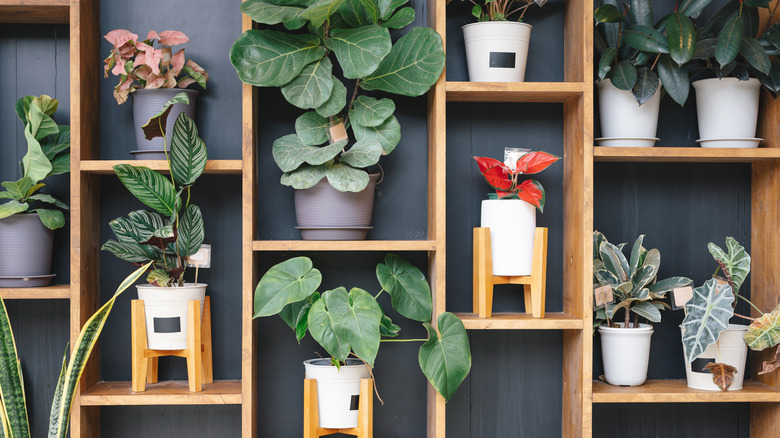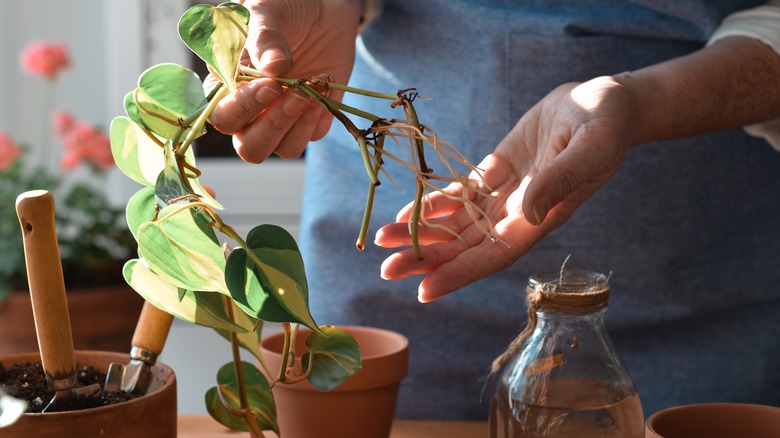What Is Keiki Paste And What Does It Do For Plants?
We may receive a commission on purchases made from links.
For plant enthusiasts, having plants reach a mature status can be quite exciting. Their foliage is vibrant, luscious, and awe-inspiring and can add visual interest to the aesthetic of your home. Having mature plants does come with a few drawbacks though. As plants reach impressive heights or lengths, their younger leaves often drop naturally with age. In this way, mature plants can develop a leggy appearance or areas of sparse foliage. One way to overcome this issue is to encourage your plant to develop new growth from existing nodes in areas where there are fewer leaves. In order to do this, you'll need help from a trendy plant accessory called Keiki paste.
Keiki paste is a hormone-based paste that stimulates the growth of new shoots or "keikis" on plants. It contains a high concentration of cytokinins, which are plant hormones that promote cell division and growth. By applying keiki paste to specific areas of a plant, you can encourage the development of new shoots.
While keiki paste is often available in nurseries and plant boutiques, it is most readily available online through Amazon. There are a few brands to choose from that offer an array of sizes, but one of the most highly rated brands is Southside Plants. This brand specializes in specifically encouraging orchids to bloom more but also claims to aid other plants like African Violets, geraniums, and roses. It costs $16.97 for 7 ml and is available on Amazon Prime.
How to use keiki paste to grow your plants
Typically, keiki paste is used to encourage indoor orchids to create new blooms, but it is also successful in encouraging other houseplants to create new growth from dormant nodes. To do so, use a sharp, clean knife to make a small incision on or just above a node on your plant. Onto the incision, apply a pea-sized amount using a sterile tool such as a cotton swab or a toothpick. Be sure to completely cover the cut with the paste. It should develop a new shoot from the area of incision in a few weeks or months. In order to increase the chances of success, it's recommended to try the application of this paste in several places on your houseplant.
Keiki paste can also be used for plant propagation. This is a great trick if you have a houseplant you'd like to clone. To do so, simply follow the steps for applying keiki paste to your plant to create a new shoot. Once that shoot has matured enough to develop several of its own nodes, it can be cut from the mother plant at the base of the shoot and rooted in clean water. Change the water weekly and once the cutting has developed fresh roots from the nodes that are at least two inches long, plant the cutting in fresh well-draining soil. You'll have successfully cloned your mother plant and can even do so again!
Why using keiki paste works
Okay, so you've given keiki paste a shot and it's working well at encouraging new growth on your precious houseplants. But how does it work? Keiki paste taps into the fascinating realm of plant hormones to stimulate impressive new growth from dormant nodes. Essentially, cytokinins are the catalysts of plant growth, signaling cells to divide and flourish. Keiki paste is a concentrated blend of these hormones, acting as a booster shot for your houseplants. When applied to dormant nodes — those seemingly inactive areas where growth is on pause — it kickstarts a burst of cellular activity usually resulting in new growth.
The paste's effectiveness lies in its ability to provide a localized hormone surge, ensuring that the energy is directed precisely where you want new growth. Additionally, keiki paste acts as a protective shield, creating a barrier that guards the treated area against external stressors, shielding them from the harsh conditions that might otherwise hinder their growth.
As with anything else, keiki paste should be used in moderation in order to avoid unintended consequences for your plants. Using it in too many places at once can actually cause your houseplant to develop weak shoots rather than the intended bushier appearance. According to the National Institute of Health, this is due to the redirection of nutrients from the roots to the shoots, which, over time, can lead to poor growth habits of your houseplants. So proceed with using keiki paste on your plants with caution!

